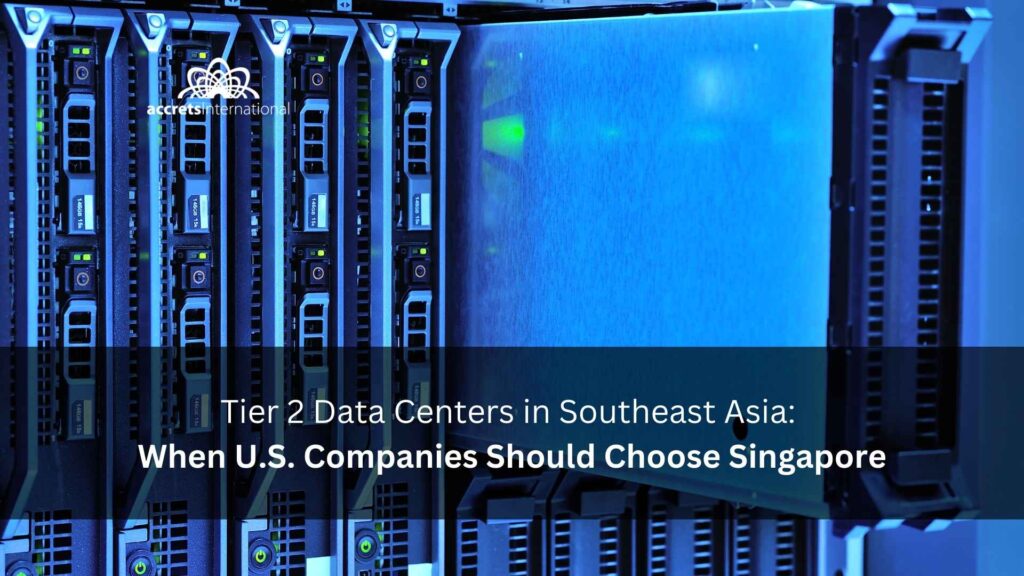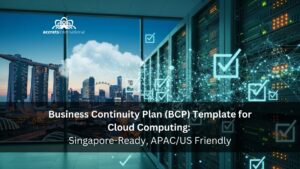If you’re a U.S. company exploring data center options in Southeast Asia, this article is your guide to understanding what a Tier 2 data center really means and whether it’s the right fit for your expansion plans, especially in Singapore, one of the region’s most reliable and connected hubs. We’ll unpack uptime expectations, use cases, compliance factors, and real-world deployment scenarios to help you decide. Let’s read this together and uncover when Tier 2 is not only “enough” but strategic.
Table of Contents
ToggleKey Takeaways: What Tier 2 Means & When It Works
- Tier 2 data centers provide redundant capacity (N+1) but only a single distribution path, offering about 99.741% availability or around 22 hours of potential downtime annually, according to the Uptime Institute.
- These centers suit non-critical production, testing environments, staging zones or even cost-optimized DR setups.
- For many U.S. companies entering Southeast Asia, especially Singapore, Tier 2 offers a lower-cost, faster-deploy alternative while maintaining basic redundancy safeguards.
If you’re still comparing options, it helps to understand where Tier 1 fits versus Tier 3, Tier 4, or even Tier 5 designs.
What “Tier 2” Really Means in Practice
A Tier 2 data center includes some essential reliability features:
- Redundant cooling and power components (N+1)
- Single delivery path for power and network
- Partial fault tolerance but no concurrent maintainability
In real-world terms, this means you can tolerate some hardware failures without impact, but any routine maintenance could cause downtime. For teams that operate in business hours only, or can afford to schedule maintenance windows, Tier 2 hits a sweet spot between cost and reliability.
Teams moving from basic facilities often view Tier 2 as a step up from Tier 1 footprints, while those under stricter uptime targets jump directly to Tier 3 or Tier 4 facilities.
Why Singapore Often Makes the Shortlist for U.S. Companies
Singapore remains Southeast Asia’s go-to infrastructure hub for a reason.
- Neutral connectivity hub. Singapore offers low-latency, high-capacity links to the U.S., China, Australia and the rest of ASEAN.
- Strong data governance. Singapore’s Personal Data Protection Act (PDPA) and Smart Nation policy reinforce a trusted ecosystem.
- Operator maturity. You’ll find local players who match U.S.-grade operations including facility audits, SLA commitments and tier transparency.
For cross-border performance, enterprises typically evaluate enterprise connectivity options or overlay networks such as Teridion-based connectivity, and even specialized routes for China when necessary.
Is Tier 2 Enough? A Decision Framework for U.S. Teams
Here’s how to assess whether Tier 2 meets your business needs:
| Factor | Tier 2 Suitability |
| SLA Required | Moderate (non-24×7 prod, test, DR) |
| Compliance | May require extra compensating controls |
| RTO / RPO | Acceptable >1 hour RTO, >4hr RPO |
| Budget Sensitivity | High, Tier 2 offers cost savings |
| Staffed Ops | Suits lean teams with managed support |
If your operating model leans on service partners, weigh managed vs. cloud service trade-offs and why a managed cloud provider matters in 2025.
Using Tier 2 Without Compromising Resilience
Smart design offsets lower-tier weaknesses.
Tier 2 (SG) + Tier 3 (MY or ID) for DR
This provides geographic diversity and active-passive disaster recovery.
Staging/UAT in Tier 2, Prod in Tier 3/4
Ideal for dev/test, offloading non-customer-facing systems.
Backup as a Service + Private Cloud
We commonly see DR built around IT DR-as-a-Service and hardened managed backup services, with on-premise private cloud for data locality.
Security & Compliance in Singapore/SEA
Singapore’s regulatory clarity gives confidence to overseas teams, but always verify:
- Facility certifications (ISO 27001, PCI-DSS, SOC 2)
- Data residency options
- Key management and encrypted backups
- Access control and incident response policies
Financial institutions exploring digital core or channel workloads often start with this primer on cloud banking in Singapore/SEA, and engage cloud security consulting early for architecture validation. Public sector workloads may follow GCC considerations alongside facility due-diligence.
Cost, Latency and Operational Trade-offs
You won’t find a single price tag, but consider these drivers:
- Power cost per kWh
- Cross-connect fees
- Remote hands SLAs
- Multi-site interconnects
Some teams offset WAN variance using enterprise connectivity overlays or tune their footprint via enterprise cloud computing services.
Colocation in Tier 2 vs. IaaS or Private Cloud
Not every firm wants to rack and stack.
If you’re comparing service models, this deep-dive on the difference between PaaS and IaaS pairs well with the advantages of IaaS and a scan of IaaS vendors in the region.
Firms modernizing virtualization stacks often shortlist VMware alternatives alongside IT infrastructure outsourcing in Singapore.
When Tier 2 Is Not Enough
You’ll need higher tiers when:
- 24×7 customer-facing services cannot afford any downtime
- Maintenance windows must be hidden from users
- Regulatory audits demand failover with concurrent maintainability
If your SLA or maintenance windows require concurrent maintainability, short-list Tier 3 facilities. Extreme resilience targets point to Tier 4 or Tier 5 designs.
Provider Evaluation Checklist
Use this list when selecting Tier 2 facilities in Singapore:
- Verified Uptime Tier certification (Design and Constructed)
- Independent audit reports (SOC 2, ISO 27001)
- Redundant UPS, HVAC, fire suppression details
- PUE and energy efficiency metrics
- Dark fiber availability, meet-me-room access
- Remote hands SLA (onsite hours, ticketing system)
- Sustainability credentials
Execution maturity shows up in downstream services. Evaluate IT implementation, managed cloud provider capabilities and the rationale for why a given partner fits your roadmap.
RFP Questions You Can Reuse
Here are sample due-diligence questions:
- What is your uptime record over the last 3 years?
- What’s your SLA for remote hands support?
- Can we co-locate backup appliances and production servers?
- What’s the procedure for scheduled maintenance notification?
- Do you provide connectivity to AWS, Azure or GCP locally?
If you expect to layer managed ops, see what managed IT services can shoulder across monitoring, patching and backup.
Where Tier 2 Fits in a Modern App Stack
Workloads such as enterprise email and Microsoft 365, online collaboration or SAP Business One often blend cloud services with regional edges. Some prefer enterprise applications services for lifecycle management.
Conclusion and Next Steps
Tier 2 data centers, especially in Singapore, strike a valuable balance for U.S. firms aiming to expand, test or support Asia-based operations without over-investing in Tier 4 infrastructure.
Start by mapping workload criticality, assessing RTO/RPO, shortlisting countries, running RFPs and validating compliance and staffing options. Design resilience into the system, not just the facility.
If you’d like a second opinion on whether Tier 2 in Singapore fits your plan, you can contact an Accrets Cloud Expert for a free consult or explore how our Managed IT Services can simplify operations while maintaining control.
Dandy Pradana is an Digital Marketer and tech enthusiast focused on driving digital growth through smart infrastructure and automation. Aligned with Accrets’ mission, he bridges marketing strategy and cloud technology to help businesses scale securely and efficiently.




